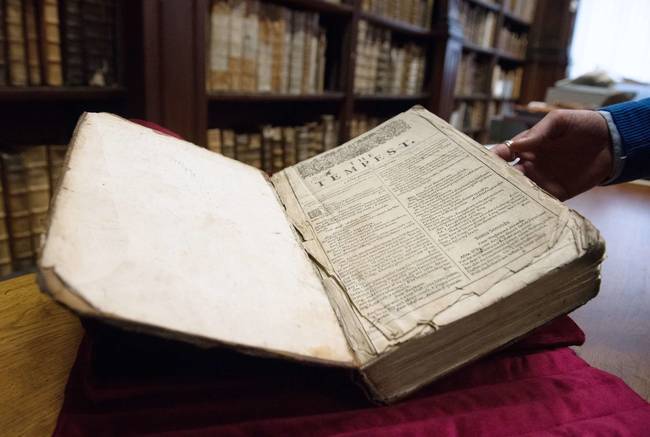Librarians at the St. Omer public library in northern France stumbled upon something extraordinary while preparing for a presentation on English literature. Though its cover and title page were torn off, an old book they discovered was in remarkable condition. Sensing they’d found something important, library director Rémy Cordonnier contacted Shakespeare expert Eric Rasmussen. Rasmussen traveled from his home in the U.S. to France, where he confirmed Cordonnier’s suspicions: they uncovered a previously unknown first folio of Shakespeare.
“This is huge,” Rasmussen told The New York Times. “First folios don’t turn up very often, and when they do, it’s usually a really chewed up, uninteresting copy. But this one is magnificent.”
Each folio is slightly different. The printing process in Elizabethan times was not like it is today. Playwrights for the most part were not too concerned about getting their works into print. Plays were mostly meant to be performed rather than read, and reading in general was less common that it is today. In fact, people thought the idea of reading rather than seeing a play was ridiculous. During Shakespeare’s time, a play would typically only be copied into one printed book, which served as a prompt book for the actors.
However, by the early 1600s, plays as reading material became a more acceptable idea. It is hypothesized that people were also starting to think ahead and wanted to preserve the plays for future audiences. In 1623, 36 of Shakespeare’s plays were collected into one volume known today as “the first folio.” About 800 copies of this book were released in 1623. Today, they are rare and incredible finds, valued at auction at $5.2 million. The book features not only the 36 plays, but also a list of the principal actors, a dedication to nobility of the day, writing on Shakespeare by other writers of the day, and a portrait of Shakespeare.
Today, the 800 folios have been tirelessly tracked down, some right to the bitter end. One folio was burned in the Chicago Fire of 1871. In 1854, another sank with the S.S. Arctic off the Canadian coast. Rasmussen says that first folios are rediscovered every couple of decades, but, as mentioned, many of them are not in good condition. This one makes 233 accounted for so far. However, even the messier ones help historians piece together the history and life of one of the most famous, but still most elusive, playwrights in the English-speaking world. Though printed together, each folio contains slight differences and tiny clues. These differences include personalized inscriptions, pieces of other writing and more, all shedding light on Shakespeare and his world. The St. Omer folio, for example, contains handwritten notes on how a play should be performed.
The folio will be on display in the St. Omer library. It looks as if the English-language literature exhibit will be a bigger hit than was anticipated. The librarians and scholars are still reeling from the incredible discovery. “Here was a text everyone knew about, that had been in the library’s holdings for four centuries,” Rasmussen said. “It’s about as Antiques Roadshow as you can get.”
(Via The New York Times)
 share
share
 share
share
 share
share



